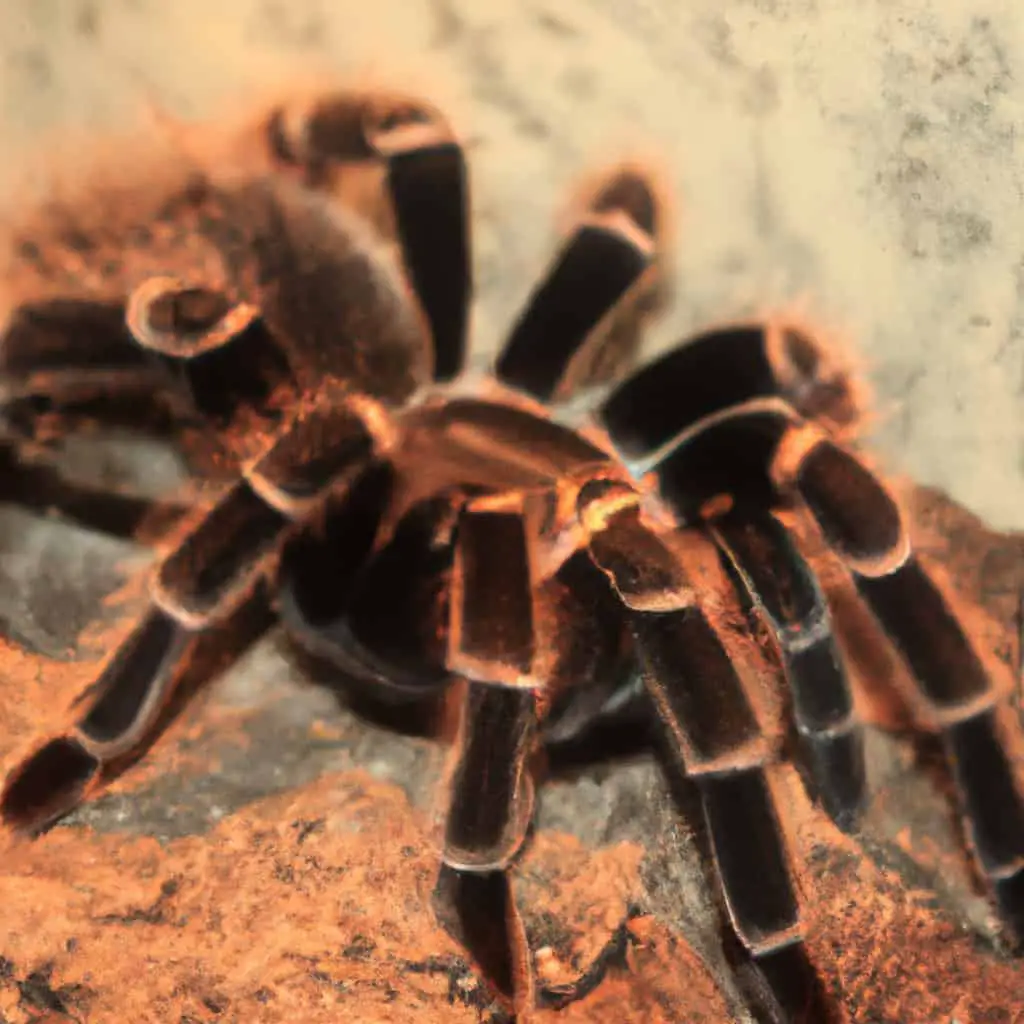What does a tarantula bite feel like? As someone who keeps tarantulas as pets, this is a question that often comes up. While tarantula bites are rare, they can happen. As a tarantula owner, it’s important to understand what a bite feels like and what to do if it happens.
Firstly, it’s important to note that tarantulas are generally docile creatures and will only bite as a last resort. However, if a tarantula feels threatened or is mishandled, it may bite. The physical symptoms of a tarantula bite can vary depending on the individual and the severity of the bite.
Key Takeaways
- Tarantula bites are rare, but can happen if a tarantula feels threatened or is mishandled
- The physical symptoms of a tarantula bite can vary depending on the individual and the severity of the bite
- If you are bitten by a tarantula, it’s important to seek medical attention if you experience severe symptoms

Understanding Tarantulas
I have always been fascinated by tarantulas, and I know I am not alone. These eight-legged creatures are often portrayed as scary and dangerous, but they are actually quite interesting and unique. Let’s take a closer look at some key aspects of tarantulas.
Species and Habitat
There are over 900 species of tarantulas, and they can be found all over the world, except for Antarctica. They range in size from as small as a fingernail to as big as a dinner plate. Most tarantulas live in warm, dry climates, and many species are found in the southern and southwestern regions of the United States.
Prey and Behavior
Tarantulas are predators and feed on insects, small animals, and even other tarantulas. They are ambush hunters and will wait in their burrows or hide in vegetation until prey comes along. Some species are known to fall from trees to catch their prey.
Male and Female Differences
Female tarantulas are typically larger and longer-lived than males. Males have smaller bodies, longer legs, and shorter lifespans. Males are also known to wander in search of mates and will sometimes be eaten by the female after mating.
Old World Tarantulas
Old World tarantulas are species found in Asia, Africa, and Europe. They are generally more aggressive and venomous than New World tarantulas, which are found in the Americas. Old World tarantulas are not recommended as pets for inexperienced keepers.
Tarantula Hairs
Tarantulas have specialized hairs on their abdomen called urticating hairs. These hairs can be flicked off the tarantula’s body as a defense mechanism and can cause irritation or even allergic reactions in humans.
Venomous Species
While most tarantulas are not considered dangerous to humans, there are some venomous species that can cause serious harm. Symptoms of a tarantula bite can include pain, swelling, and numbness. If you are bitten by a tarantula, seek medical attention if you experience severe symptoms.
Tarantula Bites: An Overview
As someone who has owned tarantulas for years, I have been asked countless times about what a tarantula bite feels like. While some sources say that it feels like a bee sting, in my experience and that of other experienced tarantula owners, it can be much more painful than that.
When a tarantula bites, it typically injects venom into the wound. The severity of the bite and the venom’s effects can vary depending on the species of tarantula and the person who was bitten. Some people may experience only mild symptoms, while others may have a more severe reaction.
In general, tarantula bites can cause pain, swelling, redness, and itching at the site of the bite. The area may also feel warm to the touch. Some people may experience muscle cramps or spasms, while others may have more serious symptoms such as difficulty breathing or anaphylaxis.
It’s worth noting that tarantula bites are relatively rare, as these spiders are not typically aggressive and will only bite if they feel threatened or cornered. If you are handling a tarantula, it’s important to be gentle and avoid making sudden movements that could startle the spider. If a tarantula feels threatened, it may adopt a “threat posture,” raising its front legs and exposing its fangs.
If you are bitten by a tarantula, it’s important to seek medical attention if you experience any severe symptoms. While tarantula bites are not usually life-threatening, they can cause serious allergic reactions in some people. In general, it’s best to avoid handling tarantulas unless you have experience and know how to do so safely.
What Does a Tarantula Bite Feel Like?
As a tarantula owner, I understand the fear and concern that comes with the possibility of being bitten by your pet. So, what does a tarantula bite feel like?
First and foremost, it’s important to note that not all tarantula bites are the same. The severity of the bite can vary depending on the species of tarantula, the amount of venom injected, and the individual’s reaction to the venom.
That being said, most people describe a tarantula bite as feeling similar to a bee sting. The bite area may become red, swollen, and itchy, with small bumps forming. Some people may also experience a burning or numbing sensation around the bite area.
In rare cases, a tarantula bite can cause the loss of blood flow to the affected area, leading to tissue damage and necrosis. However, this is very uncommon and typically only occurs with certain species of tarantulas.
If you do get bitten by a tarantula, it’s important to remain calm and seek medical attention if necessary. Wash the bite area with soap and water to minimize the chance of infection, and apply a cool compress or ice to reduce swelling.
Physical Symptoms of a Tarantula Bite
So, you’re curious about what a tarantula bite feels like? Well, let me tell you, it’s not a pleasant experience. Tarantula bites can vary in severity depending on the species of tarantula and the person who’s been bitten. Here are some of the physical symptoms you may experience after being bitten by a tarantula:
- Swelling and Redness: One of the most common symptoms of a tarantula bite is swelling and redness around the bite area. This can be uncomfortable and may last for several days.
- Itching and Numbness: Some people may experience itching or numbness around the bite area. This can be a sign of an allergic reaction and should be monitored closely.
- Rash and Fever: In some cases, a tarantula bite may cause a rash or fever. This is usually a sign of an allergic reaction and requires immediate medical attention.
- Breathing Difficulty: If you’re having trouble breathing after being bitten by a tarantula, seek medical attention immediately. This can be a sign of a severe allergic reaction.
- Eyelid Puffiness and Low Blood Pressure: In rare cases, a tarantula bite can cause eyelid puffiness and low blood pressure. This can be a sign of a severe allergic reaction and requires immediate medical attention.
- Rapid Heart Rate and Vomiting: If you’re experiencing a rapid heart rate or vomiting after being bitten by a tarantula, seek medical attention immediately. These can be signs of a severe allergic reaction.
It’s important to note that not all tarantula bites are the same. Some people may experience more severe symptoms than others, and some species of tarantula are more venomous than others. If you’ve been bitten by a tarantula and are experiencing any of the above symptoms, seek medical attention immediately.
Severe Reactions to Tarantula Bites
If you’ve been bitten by a tarantula, it’s important to know when to seek medical help. While most tarantula bites won’t cause severe reactions, some people may experience a severe allergic reaction that requires immediate medical attention.
Symptoms of a severe reaction can include:
- Trouble breathing
- Chest pains
- Abdominal cramps and nausea
- Low blood pressure and collapse (shock)
- Rapid heart rate
- Swelling of the lips and throat
- Skin rash
If you experience any of these symptoms after being bitten by a tarantula, it’s important to seek medical help immediately. An allergic reaction can quickly become life-threatening if not treated promptly.
When you arrive at the emergency room, medical professionals will likely take your vital signs, including your blood pressure and heart rate. They may also order blood and urine tests to check for signs of an allergic reaction.
Depending on the severity of your symptoms, you may require breathing support, such as oxygen therapy or a breathing tube. You may also need a chest x-ray or electrocardiogram (ECG) to check for any damage to your heart or lungs.
Intravenous fluids and medicines may be given to help manage your symptoms, and you may need to stay in the hospital for observation. In rare cases, a severe allergic reaction to a tarantula bite can be fatal.
Remember, most tarantula bites won’t cause severe reactions, but it’s important to know when to seek medical help if you experience any concerning symptoms.
Treatment and First Aid for Tarantula Bites
If you are bitten by a tarantula, it is important to seek medical attention as soon as possible. However, there are some things you can do to help alleviate symptoms and reduce the risk of infection before you can get to a doctor.
The first step is to clean the affected area with soap and water. This helps to remove any dirt or bacteria that may have entered the wound. After cleaning, apply a cold compress or ice wrapped in a clean cloth to the bite site. This can help to reduce swelling and numb the area to reduce pain.
If you are experiencing itching or irritation, you can apply an anti-itch cream or a paste made from meat tenderizer and water. This can help to reduce inflammation and irritation.
If you are experiencing an allergic reaction, you may need to take an antihistamine or seek medical attention immediately. Symptoms of an allergic reaction can include difficulty breathing, swelling of the face or throat, and hives or rash.
It is important to monitor the bite site for signs of infection, such as redness, swelling, or discharge. If you notice any of these symptoms, seek medical attention right away.
In general, it is best to avoid touching or handling tarantulas, as they are known to bite when threatened. If you do come into contact with a tarantula, use caution and try to gently remove it with a piece of sticky tape or a container.
Remember, if you are bitten by a tarantula, seek medical attention as soon as possible. With proper treatment and care, most people are able to make a full recovery.
Dangerous Spiders Compared to Tarantulas
As someone who has been bitten by a tarantula before, I can tell you that it is not a pleasant experience. However, compared to some other dangerous spiders, a tarantula bite is relatively mild.
Let’s take a look at some of the most dangerous spiders out there and compare them to tarantulas.
Black Widow
The black widow is one of the most well-known dangerous spiders. Their venom is incredibly potent and can cause muscle cramps, sweating, headache, abdominal cramps, and more. In severe cases, it can even be fatal.
Compared to a black widow, a tarantula bite is much less severe. While you may experience some pain, itching, numbness, redness, and swelling, you are unlikely to experience any of the more severe symptoms associated with a black widow bite.
Brown Recluse
The brown recluse is another dangerous spider that you definitely want to avoid. Their bites can cause skin damage, cramping, sweating, and more. In some cases, the skin around the bite can even turn black and die.
Again, compared to a brown recluse, a tarantula bite is much less severe. While you may experience some pain and swelling, you are unlikely to experience any of the more severe symptoms associated with a brown recluse bite.
Other Dangerous Spiders
There are many other dangerous spiders out there, including various types of recluse spiders. While the severity of their bites can vary, they are all generally more dangerous than a tarantula bite.
In some cases, a tarantula may even give a “dry bite,” which means that they do not inject any venom into their victim. While this can still be painful, it is much less severe than a venomous bite.
Overall, while a tarantula bite is not something you want to experience, it is much less severe than the bites of many other dangerous spiders.
Prevention and Safety Measures
When it comes to tarantula bites, prevention is the best course of action. Avoiding contact with tarantulas is the easiest way to prevent a bite. If you are in an area where tarantulas are prevalent, be sure to wear protective clothing and shoes. It is also important to be aware of your surroundings and avoid putting your hands or feet in areas where tarantulas may be hiding.
If you do encounter a tarantula, it is important to remain calm and avoid provoking the spider. Tarantulas are generally not aggressive and will only bite if they feel threatened. If you must handle a tarantula, be sure to do so with care and only handle them with gloves or other protective gear.
In the event of a tarantula bite, it is important to seek medical attention immediately. While most tarantula bites are not severe, some individuals may experience severe symptoms such as breathing difficulties or loss of blood flow to major organs.
If you are in a wilderness area and are bitten by a tarantula, it is important to seek medical attention as soon as possible. Wilderness medicine experts recommend carrying a first aid kit with you at all times, including items such as antihistamines, pain relievers, and bandages.
Overall, the best way to prevent a tarantula bite is to avoid contact with the spiders altogether. If you must handle a tarantula, be sure to do so with care and always seek medical attention if you are bitten.
Frequently Asked Questions
Are tarantula bites poisonous to humans?
Tarantula venom is not usually dangerous to humans. While some species have venom that can cause severe reactions, most tarantulas have venom that is about as dangerous as a bee sting. However, some people may be allergic to tarantula venom, and in rare cases, a bite can cause anaphylaxis. If you experience any severe symptoms after a tarantula bite, seek medical attention immediately.
What does a tarantula bite feel like?
The sensation of a tarantula bite is often described as similar to a bee sting. You may feel a sharp pain at the site of the bite, followed by a burning or itching sensation. Some people report feeling numbness or tingling in the affected area. The bite may also cause redness and swelling.
How likely is a tarantula to bite you?
Tarantulas are generally not aggressive toward humans and will only bite if they feel threatened or provoked. If you handle a tarantula gently and with care, the chances of being bitten are very low. However, if you startle or provoke a tarantula, it may bite in self-defense.
Can you feel a tarantula on you?
Tarantulas are usually quite large and can be felt crawling on your skin. However, they are also very light and can move quickly, so it’s possible for a tarantula to crawl on you without you noticing. If you’re handling a tarantula, be sure to keep a close eye on it at all times.
Do pet tarantulas bite?
Pet tarantulas are generally docile and will not bite unless they feel threatened. However, it’s important to remember that tarantulas are wild animals and can be unpredictable. If you’re considering getting a pet tarantula, do your research and make sure you’re prepared to handle and care for it properly.
How to treat a tarantula bite?
If you are bitten by a tarantula, wash the bite with soap and water and apply a cold compress to reduce swelling. If you experience any severe symptoms, seek medical attention immediately. Most tarantula bites are not serious, but it’s always better to be safe than sorry.








